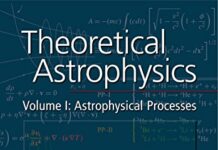
Ebook Info
- Published: 2010
- Number of pages: 728 pages
- Format: PDF
- File Size: 3.60 MB
- Authors: T. Padmanabhan
Description
Covering all aspects of gravitation in a contemporary style, this advanced textbook is ideal for graduate students and researchers in all areas of theoretical physics. The ‘Foundation’ section develops the formalism in six chapters, and uses it in the next four chapters to discuss four key applications – spherical spacetimes, black holes, gravitational waves and cosmology. The six chapters in the ‘Frontier’ section describe cosmological perturbation theory, quantum fields in curved spacetime, and the Hamiltonian structure of general relativity, among several other advanced topics, some of which are covered in-depth for the first time in a textbook. The modular structure of the book allows different sections to be combined to suit a variety of courses. Over 200 exercises are included to test and develop the reader’s understanding. There are also over 30 projects, which help readers make the transition from the book to their own original research.
User’s Reviews
Reviews from Amazon users which were colected at the time this book was published on the website:
⭐Great textbook/reference! His discussion of Special Relativity with emphasis on topics you need for the General Relativity portions are quite interesting, lots of discussion of distribution functions and fluids. Seems a solid Foundations side with interesting looking Frontiers section. He does use the notation (as Chandrasekhar?) that the roman alphabet indices are 0 to 3, while the greek indices are the space components 1 to 3. The opposite of what I was used to. Took me a bit to become used to it, but context and author are helpful. Great book!
⭐Really good…No, excellent indeed. If you want to know why gravity is constructed in the way it is and how from a very few principles, this is your book. I’ve never seen this detailed, rigorous and clear presentation of General Relativity.
⭐In Memoriam:Thanu Padmanabhan(10 March 1957 – 17 September 2021).I have long intended to write a review of Padmanaban’s text on Gravitation (Einstein’s General Relativity). Sadly, his untimely passing compels me to write some scattered remarks. His text is a paragon of lucidity and should be better known than it is: study it, as it is beautifully written. Also, view his online-lectures: they are beautifully presented. I have long felt that Padmanabhan’s book is more the “nutshell” book that Zee should have written (Zee is discursive where Padmanabhan is straightforward.). If you enjoy the “Lagrangian” viewpoint, you will enjoy this text, as “these ideas will be used extensively” (page 29).(1) You get an “action comparison” Table (page 58). Exercises are always key. Delight in an exercise #2.24 (page 100), standard results about radiation. Learn how to move from proper time to coordinate time in the service of electrodynamics (recalling a formula discussed in Feynman’s lectures, volume 1, page 28-2, also, see Garg’s Electromagnetism text, page 213).(2) Chapter five reinforces chapter two. You “modify” the action(s) to make them “generally covariant.” (page 217). Scalar field theory, then vector field theory. Read: “we have repeatedly used this feature in several previous chapters….” (page 221). That phrase summarizes the pedagogic virtue of this textbook– reinforcing each topic through multiple encounters. Sometimes described as the “spiral” approach.(3) Remain with exercises: notice project 5.1 (page 237): “it turns out that knowledge of the holonomy of every possible loop is equivalent to knowing the metric.” This is a beautiful and thoughtful exercise !(4) Chapter six is Einstein’s field equations. Of course, we begin with, then reinforce, “action functionals.”This is an outstanding presentation. Read: “let us now consider a few simple physical systems…to convince ourselves that we get reasonable results.” (page 252). Read of “…subtle role played by general covariance and the principle of equivalence…” (pages 255-256).(5) Jump ahead to chapter nine and get an exercise in “lessons from gravity for electromagnetism.” Read:”it is possible to study the simpler case of electromagnetic radiation exactly in analogy with gravitational radiation.” (page 433). From there, get a nice discussion of general relativistic effects in binary systems.Observational aspects of binary pulsars follows (page 438), then follows more radiation (page 443).(6) A synopsis of the “language” of differential forms awaits for chapter 11. Read: “earlier, we introduced the concepts of connections and curvature through the covariant derivative operator, we shall now re-do the same using the language of exterior calculus…” (page 519). And, so we do ! After which, “reformulate” the gravitational action principle. Then, try your wits at gauge theories. Sound pedagogy !(7) A treat awaits in the section of “key results of quantum field theory” (chapter 14), following which, an introduction to path integrals (pages 598-602). Read of: “inflationary scenario” and “the simplest way to realize such a phase is to postulate the existence of a scalar field with a nearly flat potential” (page 632).(8) There is more I could write about this lovely book. It is interesting to compare and contrast with Zee’s “nutshell.” My tastes are such that I prefer Padmanabhan’s approach. Even if you do not have access to the book, view his online lectures. Remember to view his 2017 online lectures: Action In Physics.This is a physicist who knows his material and presents it very well, indeed. Pay homage to his legacy.Highly recommended !
⭐It’s surprising this book hasn’t received any reviews here. This is possibly one of the finest general relativity textbooks existing today. Superbly modern in it’s exposition of the general relativity. If you’re asking why the IRF moves on geodesics, you’ll find the answer to that here. If you’re wondering why the relativistic Lagrangian is integral of mc^2 ds, you’ll find the answer to that here, rather than shady arguments used in other books. Practically everything here is derived from variational principles, so GR just feels so natural. It’s hard to believe that GR could even be thought of in such an eye-opening way. I can only imagine what a good expositor Professor Padmanabhan is like in real life.The Pros of the book:*The most illuminating problems and projects not present in any other book.*Clear, concise writing and conceptual detail*Covers modern topics like QFT in curved spacetime (I haven’t gotten here yet though)*Gives an introduction to the formulation of GR using differential forms*The only prerequisites are some analytical mechanics at the level of Goldstein, some basic electrodynamics, and some special relativity. He doesn’t even assume any familiarity with 4 vectors. However, a prior acquaintance with GR would be good to have, I learnt my GR the first time with Hobson, Efstathiou and Lasenby, and then moved to this.*Almost no typos.The Cons:*Cosmology section is very brief and this could have been expanded greatly. This was disappointing and it felt like a stumble in the book. Then again, this is hardly an issue considering the entire book.In all, this book is pure gold. If 6 stars were available, I’d give it that.
⭐It is a bit of Steven Weinberg’s Gravitation and Cosmology, another bit of Wheeler, Misner, Thorne’s Gravitation and another bit of Wald’s General Relativity all combined into one book so that it can serve as a textbook for a course on Gravitation. Seeing a bit of emergent gravity at the end was a surprise.
⭐I have been using this book, as a primary source on General relativity, as a part of my background study for my PhD. I had a GR course in my post graduation, where we followed “Lectures on General Relativity” by A Papapetrou. This book by Padmanabhan has cleared several doubts I had when I did the last course and has made me realize how elegant is a theory when formulated through action principle. The book first sets up special relativity and relativistic electrodynamics through the action principle. The 4-Vector potential is shown to be naturally occurring when we formulate the dynamics by an action. From the beginning to the end of this book, the action principle is used to do General relativity in a way that is completely modern. Further, one could also follow his video lectures on youtube(Course on General Relativity) which would do hand in hand with studying the book(That is what I did). This book does what Padmanabhan claims in his preface – it fills the need for a book on general relativity which is modern in its outlook and emphasis.
⭐This book is an advanced general relativity reference book. It’s interesting how the author presents his arguments from scratch. I wish Dr. Thanu padmanabhan spoke more about the black hole thermodynamics in this book.
⭐Esse livro é fantástico. Sem comentários.
⭐
⭐Those who study/research on Relativistic Astrophysics and Cosmology have certainly heard of Padmanabhan before. I was aware of his work before but never knew of such an amazing book on Relativity until I found out about it online. I took it from the school library and was not disappointed.This book brings every element of modern GR with lucid explanations, examples and commented exercises. The exercises don’t have solutions, and some of them are quite challanging; you’ll sometimes find that they are actually subjects of papers from the 80’s; but they are a pleasure to solve, and in a huge quantity. Padmanabhan’s discussion on Special Relativity is much more enlightening than any other book I know on GR, and opens the path to GR quite naturally. The advanced topics are also very interesting and modern, especially the one on entropic gravity.If I have to point out any flaws, is that the book doesn’t cover integration on manifolds very well. I suggest reading Poisson’s Relativisti’s Toolkit book on that subject, as it contains the most complete section on integration and properties of hypersurfaces I know of. Otherwise Padmanabhan’s book is self-contained, profound, advanced but fully permitting a beginner to start his studies of GR from this book. Maybe, if he wants, reading Wald or Carroll at the same time would be a good idea.NOTE: so far, I’ve only found a mistake in Eq. (1.120) ; there should me a minus on the RHS.
Keywords
Free Download Gravitation: Foundations and Frontiers 1st Edition in PDF format
Gravitation: Foundations and Frontiers 1st Edition PDF Free Download
Download Gravitation: Foundations and Frontiers 1st Edition 2010 PDF Free
Gravitation: Foundations and Frontiers 1st Edition 2010 PDF Free Download
Download Gravitation: Foundations and Frontiers 1st Edition PDF
Free Download Ebook Gravitation: Foundations and Frontiers 1st Edition


